A riddle, a mystery and an inigma
By Al R. Young
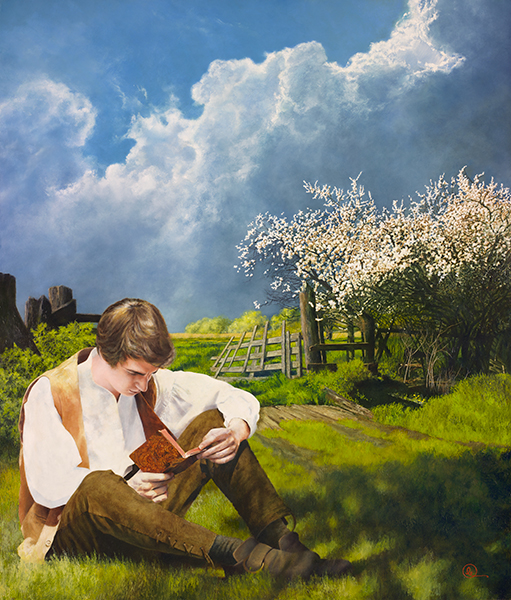 |
| The Dawning Of A Brighter Day (Joseph Smith) by Al R. Young |
dimensions (unframed width x height)
37.75 in. x 44.5 in.
support
Panel
milestones
Photo shoot for figure – 2009 May
Brushwork begins on original composition – 2011 October
Photo shoot from which fruit tree was taken – 2012 April
New composition formulated and brushwork begins – 2012 May
Painting completed – 2014 December
Based on regular entries in the project journal for this painting, creation of the artwork involved approximately 107 sessions (from composition and panel preparation to completion of brushwork). Sessions can last as long as eight hours or be as short as half an hour.
equipment
Creating a painting often involves creating or modifying tools or making improvements to the studio itself. This painting project necessitated the following activities in terms of tools, supplies, and operations.
None created or modified for this project.
Costumes, miniatures, and props
Sometimes these items must be created at the Studios, sometimes they are purchased for the project, and sometimes items created or purchased for other projects are re-used or modified. This section does not list every costume element, miniature, or prop that may have been involved in the project. Instead, we include items whose story might prove interesting or useful.
None created or modified for this project. Items were drawn from Studios costume storage.
methodology
This section presents only one or two items that may be of interest to professional artists, amateurs, and others interested in the work of the Studios.
During a BBC radio broadcast entitled "The Russian Enigma" (1939 October 1), Winston Churchill declared: I cannot forecast to you the action of Russia. It is a riddle, wrapped in a mystery, inside an enigma; but perhaps there is a key. That key is Russian national interest.
In approaching the subject of the creation of The Dawning Of A Brighter Day the idea expressed in Churchill’s well known metaphor came to mind. For in the minds of many, the work of the studio artist remains a riddle. And the artist’s studio—so often envisioned simplistically as consisting of an easel, a palette, some brushes, and a solitary artist—continues to be the wrapper around the mystery.
My objective in this brief commentary is only to shine a little light on the riddle and the mystery. In doing so, I cannot help but touch, if only lightly, upon the enigma of the creative process and pass by the key concerning why a particular artist selects (or, more precisely, is selected for) a particular subject. (I prefer selected for because of the way Arnold Friberg once described that aspect of the process: A picture comes tapping on my shoulder, saying, 'Here I am. Spiritually I already exist. Now is the time that I shall come into reality, and from among the world’s artists you have been selected to deliver me into mortal existence. You cannot escape. I will give you no peace by day or by night until you have fulfilled your duty.')
the riddle
No painting occurs in isolation. It is part of the artist’s oeuvre—a usage deriving from the French word for work, oeuvre (1875)—and referring to the body of work (i.e., the life’s work) of an artist, writer, composer, etc. It is my experience that every artwork; indeed, every project, whether completed or not, is:
Connected to every other project an artist creates, and to the influential works of other artists.The connectedness of an artist’s works results from what I think of as a journey and, like all journeys, involves a terrain—a topography—complete with obstacles. Even though I do not hope for obstacles, it often happens that an obstacle is simply an elevated place from which to get a better view, greater understanding, more skill, etc.
An opportunity for the artist to increase in understanding, skill, and stamina.
Perhaps the most important feature of the connectedness of projects is that every project can be connected to at least one of two things: quitting or completion. And while completion is almost always reflexively perceived as a good thing, I think there is more to it than that. Deciding when to quit and when to persevere is really a matter of deciding whether completion means completing the work at hand (the project already begun) or completing another painting instead.
The Dawning Of A Brighter Day provides an example: Having completed the photo shoot for the figure, which was conducted out of doors, the next step was to compose an outdoor setting in which to present the figure. Since the geographic location of the actual historical setting for the subject is known, my efforts initially focused on scenes from the farm where the Smith family resided in 1820. A composition resulted from these efforts and brushwork on that composition was commenced. Problems developed, however, and while making arrangements for a solution, another photo shoot for another project—completely unrelated to The Dawning Of A Brighter Day —resulted in outdoor images (i.e., a rural setting) that caught not only my eye, but entirely captivated my imagination and fired my enthusiasm.
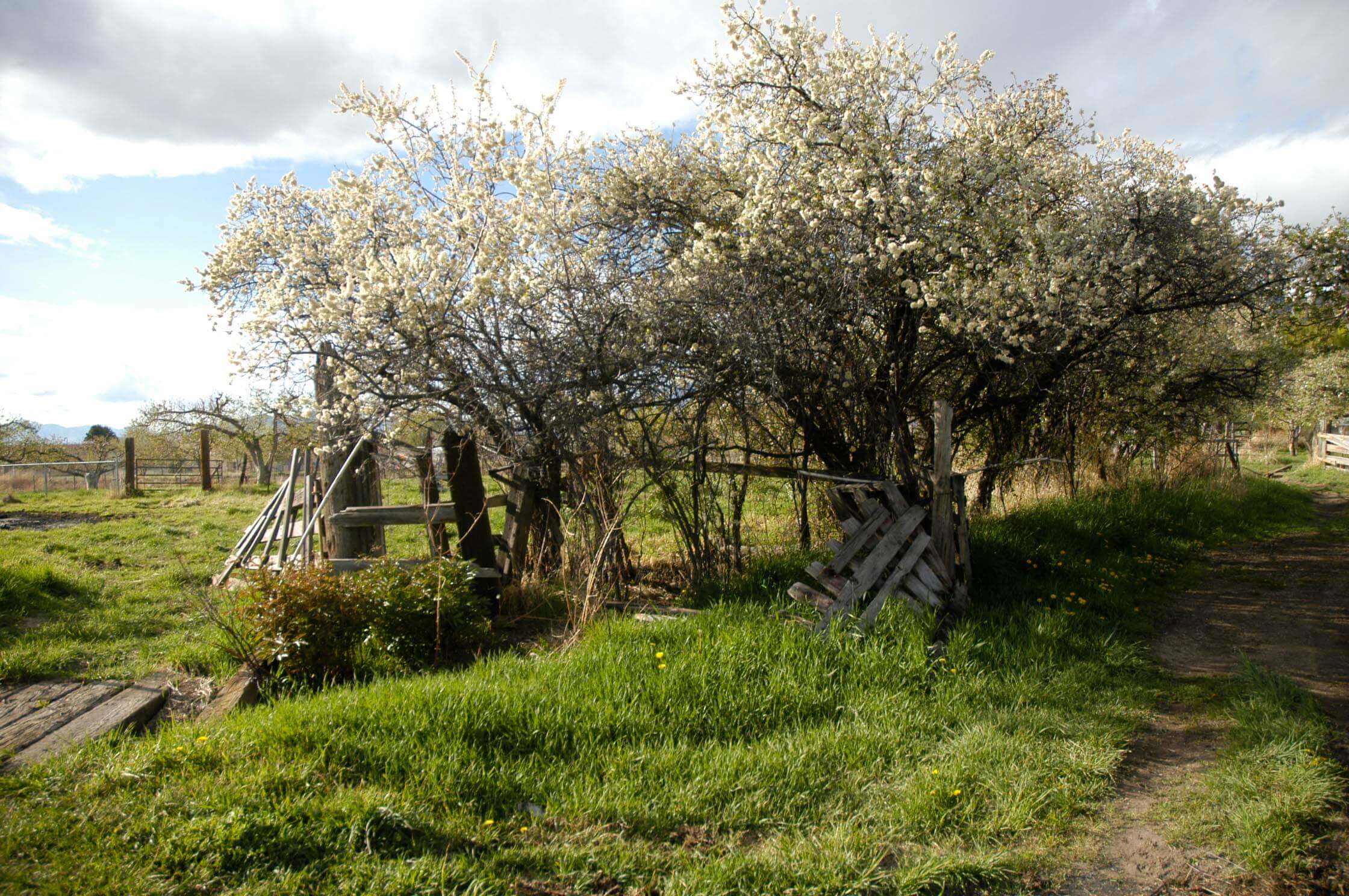 |
| One of the many photographs from the setting for the painting. |
The foregoing image is a detail from among the scores of photos taken for that other project. When I first saw the image, it jumped out of the batch of images and all but announced to me that (as Arnold Friberg described it) "you have been chosen to paint me." I felt strongly about the background image from the photo shoot, perhaps because a compositional feature of such magnificent complexity would significantly affect the time and effort required to complete the work. (In other words, I had a strong feeling that I ought to paint the subject. It wasn’t presented to me merely as a good idea, but with that fire of feeling that usually means this is going to be challenging and take a while.) In my original composition, the setting was far simpler.
Up until that moment in the timeline of the project I did not realize that I was supposed to paint not merely a historical vignette, but an allegory. Just because an artist knows he is to paint a particular subject, does not mean he knows why or how or even when. For me, such knowledge usually emerges along the way, particularly as the knowledge is needed to keep me going. And some of that knowledge—if it comes at all—comes after the artwork is completed; sometimes long afterward.
Given the blossoming fruit tree in the mid-ground of the composition, I immediately set about designing a sky for the painting. The figure remained in the foreground situated and posed as originally envisioned, but, given the fruit tree, a completely different sky was called for. Indeed, the proportions of the image changed and the complexities and sense of spaciousness in the new composition were altogether different from my earlier attempt.
In addition to the fruit tree and fields, I began searching for a sky consistent with how I felt in connection with the fruit tree. In other words, the new background asserted itself—its mood, its message, its own part of the story—as though it were a figure.
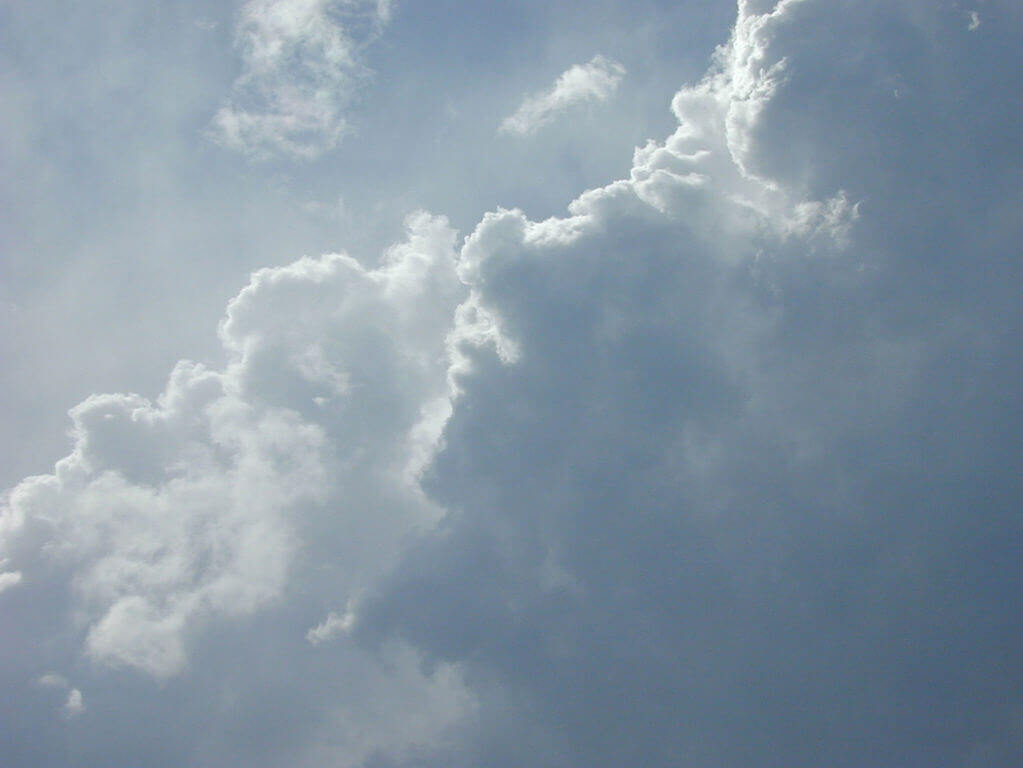 |
| The referent photograph for the sky. |
To have persevered with the original composition—to have completed it—would have been a great mistake. That Spirit that watches over artistic endeavor wanted to lead me in a completely different direction. Thus, the panel and the brushwork from that original attempt were plowed back into the furrows of studio projects so that some found their way as renewed panels for use in other paintings while some pieces were actually included in building projects, perhaps to provide mystery and entertainment for art historians yet unborn.
With the new composition in place, the rest of the narrative about the completion of the painting is primarily a narrative about brushwork, and probably falls under the heading of the artist’s ongoing development of understanding, skills, and staminas, but even that aspect of completion involves other studio projects. For example, the initial rendering of the sky in The Dawning Of A Brighter Day was painted before Den Kommende Våren. Only after completing that painting did I return to The Dawning Of A Brighter Day. And when I did so, the rendering of its earlier sky fell short of the mark of quality achieved in Den Kommende Våren. Compositionally, the new sky in The Dawning was right, but I had learned some things during the rendering of the sky in Den Kommende Våren , and so refined the sky accordingly.
Another feature of The Dawning—the thicket of limbs and fence parts, shrubs and grasses associated with the fruit tree—had yet to be rendered. Having completed the sky, I stepped toward the tree and it proved almost as challenging as I had feared. Not since And I Will Not Deny the Christ had I attempted such a complex and dominant botanical subject. Nevertheless, I was determined to reach as far as possible toward the skill of such artists as John William Waterhouse, in rendering complex botanical subjects.
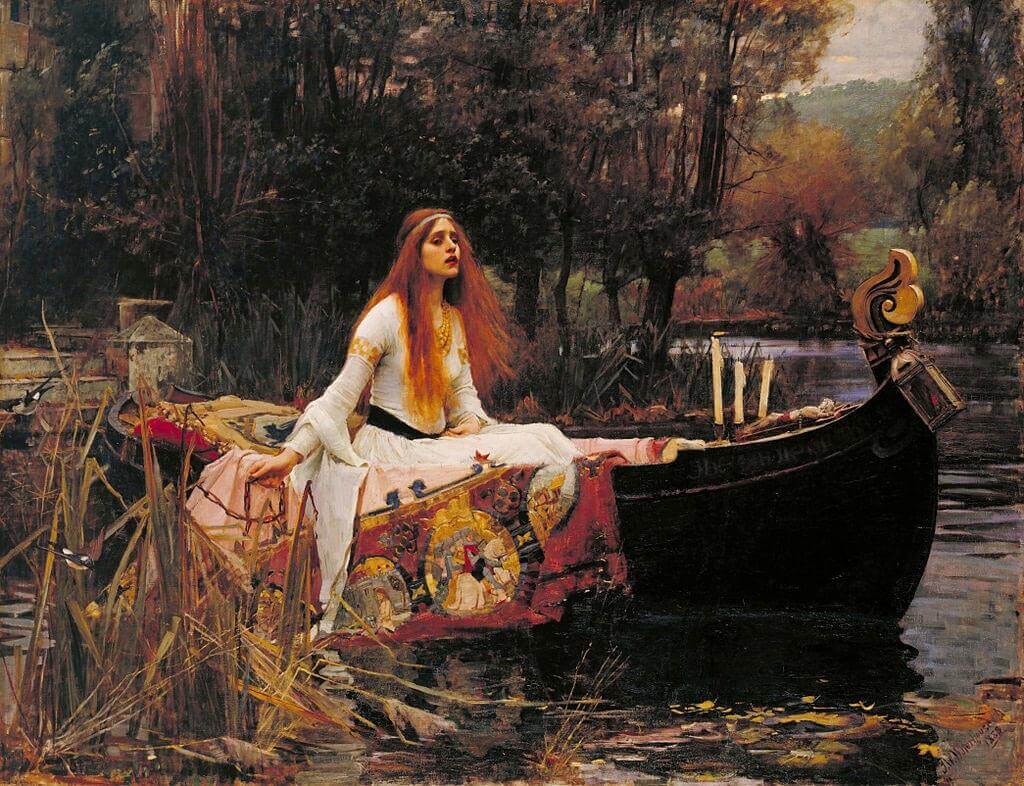 |
| The Lady of Shallot by John William Waterhouse |
Of all the areas of experience involved in this project, perhaps the linen of Joseph Smith’s blouse constitutes the most rewarding of the technical vistas available from this particular project. Some of the most enjoyable experiences of my artistic travels through textiles might include the rendering of the leather appearing on the figure in Not Knowing Beforehand and the ephemeral quality of the robes in the three paintings of The Messiah, as well as the coarseness of the robe in He Hath Anointed Me , the back-lit quality and prismatic reflecting of the fabrics in Under Whose Wings Though Art Come To Trust are moments of particular personal delight. But the pleats and folds and creases at the shoulder seam in the sunlit blouse of this figure were a particular delight.
The technique by which they are presented has been developing all along the way, and, except for very early works, is not a technique I would use instead of the rendering in the other paintings mentioned. And not all of the preparation for the technique has been confined to textiles. The preparation is really everywhere, even in the lithographs. The technique involves layering, which involves patience, which involves believing and courage and hope—not to mention delight, which depends in no small degree, upon surprise, near the end when everything comes together suddenly and almost (but not quite) unexpectedly.
the mystery
As the milestones (above) indicate, this painting was completed over a period of five and a half years. The fact that the artwork was not commissioned meant that other artworks having deadlines associated with them periodically took precedence. This is an important factor in the ongoing work of the Studios, and requires that each project be sufficiently documented while still in progress, so that interruptions do not pose a problem. Indeed, I have come to understand that that Spirit that watches over artistic endeavor watches over interruptions so that time spent on one project—even at the expense of other projects—usually constitutes a tutorial, the completion of which lays the groundwork for a much better result when work on an earlier project resumes.
The earliest of the photographs involved in the background of the finished painting were taken in February 2008. The shoot for the figure was completed in May 2009. A shoot from which the elements of the foreground and background derive was completed in May 2012. Consequently, the photograph of the sky was taken before the creation of this particular painting began, but not before the idea or possibility of such a project had been on my mind.
Like any artwork, the work on this painting has been going on for untold years and decades. From amorphic feelings and flickers of ideas, to paintings whose final brush strokes are drying and beyond, the work of the Studios is essentially timeless, consisting of shepherding toward completion all of the individual expressions of ideas strung out like a wagon train on the expansive horizon of possibility.
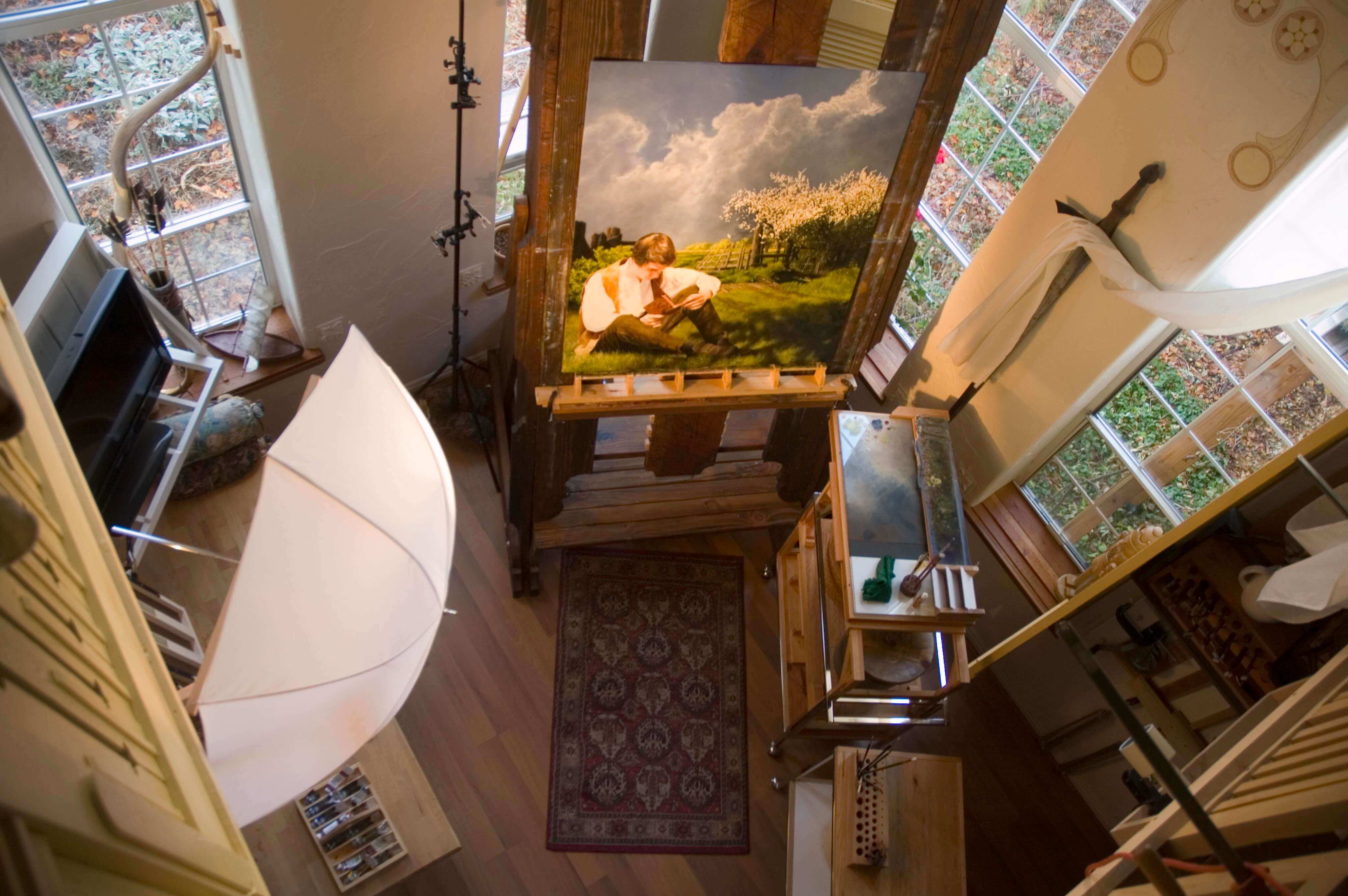 |
| Looking down into the studio during a painting session near the end of the project. |
Tags: The Dawning Of A Brighter Day, 2016, Project commentaries, Tips and techniques
Browse articles by year: 2025 . 2024 . 2023 . 2022 . 2021 . 2020 . 2019 . 2018 . 2017 . 2016 . 2015 . 2014 . 2013 . 2012 . 2011 . 2010 . 2009 . 2008 . 2007 . 2006 . 2005 . 2004 . 2003 . 2002 . 2001 . 2000 . 1999 . 1998 . 1997 . 1996
Browse articles by topic: Art lessons . BenHaven Archives . Blank art diaries . Fine art photography . Framing . Illustration . Inspiration and creativity . Isles of Rune . Limited Editions Collection . My Fathers Captivity . News . Novellas . Oil paintings and prints . Operations announcements . Orders and shipping . Overview . Portfolios . The Papers of Seymore Wainscott . Project commentaries . Recipes by Nancy Young . Recommended reading . Recommended viewing . Temple artworks . The Storybook Home Journal . Tips and techniques . Tools supplies and operations
Browse articles by topic: Art lessons . BenHaven Archives . Blank art diaries . Fine art photography . Framing . Illustration . Inspiration and creativity . Isles of Rune . Limited Editions Collection . My Fathers Captivity . News . Novellas . Oil paintings and prints . Operations announcements . Orders and shipping . Overview . Portfolios . The Papers of Seymore Wainscott . Project commentaries . Recipes by Nancy Young . Recommended reading . Recommended viewing . Temple artworks . The Storybook Home Journal . Tips and techniques . Tools supplies and operations